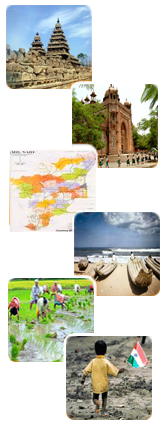TamilSelvi Articles
Monday, May 19, 2008
South India: Rich Tradition and Diverse Culture
South India is the area comprising of the southern states of Tamilnadu, Kerala, Karnataka, Andhra Pradesh, Lakshadeep and Pondicherry. The geography of the region is diverse, encircled by two mountain ranges - the western and eastern ghats and a plateau heartland. The Thungabhadra and Kaveri rivers are the two most important though not perernnial sources of water. People of this region speak one of the four Dravidian languges- Tamil, Kannada, Telugu or Malayalam. During its chequered history, a number of dynastic kingdoms ruled over various parts of South India. The rich culture of South India is reflected in her dance, clothing, and sculptures.
Rice is the staple diet of people living in South India. Coconut is widely grown in Kerala is an important ingredient in Kerala cuisine. In Andhra Pradesh food is characterized by hot and spicycurries. Dosa and Idli are two most popular snacks of South India which have now acquired international renown.
South India is well known for its musical tradition, which includes music composed by stalwats like Thyagaraya, Muthuswami Dikshitar and Shyama Sastri. South India is also noted for several unique and distinct dance forms - like Bharatanatyam, Kathakali, Mohiniattam, Kuchipudi etc.
South India has a rich and varied literary tradition dating back over 2000 years. The first known literature of South India belongs to the sangam period, which were written in Tamil narly 1800 years ago. The 850 CE Kannada classic Kavirajamarga makes references to Kannada literature of King Durvinita of the early sixth century CE. Distinct Malayalam and Telugu literary traditions developed in the centuries that followed.
South India has two different styles of rock architecture - the Dravidian style of Tamil Nadu and the Vesara style of Karnataka. The countless imposing temples and several magnificent sculptures of Chenai, Mahabalipuram, Madurai, Thanjavur, Hampi, Mysore, Thirupathi, Shravanabelagola, Thiruvananthapuram and several such places and the mural paintings of Travancore bear ample testimony to South India culture. The paintings of Raja Ravi Varma are considered classic renditions of many a scenes of South Indian life and mythology.
South India has always been a preferred wildlife destination with lush evergreen vegetation, tropical dry forests, scrub lands and moist forests. South India is home to some of the best Indian wildlife sanctuaries like Periyar National Park, Nilgiri Biosphere Reserve, Mudumalai National Park, Silent Valley National Park, Wayanad Wildlife Sanctuary, Idukki Wildlife Sanctuary, Thekkady Wildlife Sanctuary, Kumarakom Bird Sanctuary, Kunthakulam Bird Sanctury, etc
The spiritual traditions of South India include Saivite and Vaishnavite philosophies of Hinduism. Buddhism and Jainism were also predominant religions in the earlier cenuries. There is a dominant Muslim community in South India, particularly in the Malabar coast of Kerala, Hyderabad and several parts of Tamilnadu. Christianity has flourished in coastal South India from the time of St. Thomas who is believed to have come to Kerala and established the Syrian Christian tradition. Kerala is also home to one of the oldest Jewish communities.
South India has always attracted tourists from all parts of the world. The picturesque landscapes, the time-honored ancient temples, the rich culture, spicy and delicious food, art and architecture - all combine to makes South India a haven for tourists.
Rice is the staple diet of people living in South India. Coconut is widely grown in Kerala is an important ingredient in Kerala cuisine. In Andhra Pradesh food is characterized by hot and spicycurries. Dosa and Idli are two most popular snacks of South India which have now acquired international renown.
South India is well known for its musical tradition, which includes music composed by stalwats like Thyagaraya, Muthuswami Dikshitar and Shyama Sastri. South India is also noted for several unique and distinct dance forms - like Bharatanatyam, Kathakali, Mohiniattam, Kuchipudi etc.
South India has a rich and varied literary tradition dating back over 2000 years. The first known literature of South India belongs to the sangam period, which were written in Tamil narly 1800 years ago. The 850 CE Kannada classic Kavirajamarga makes references to Kannada literature of King Durvinita of the early sixth century CE. Distinct Malayalam and Telugu literary traditions developed in the centuries that followed.
South India has two different styles of rock architecture - the Dravidian style of Tamil Nadu and the Vesara style of Karnataka. The countless imposing temples and several magnificent sculptures of Chenai, Mahabalipuram, Madurai, Thanjavur, Hampi, Mysore, Thirupathi, Shravanabelagola, Thiruvananthapuram and several such places and the mural paintings of Travancore bear ample testimony to South India culture. The paintings of Raja Ravi Varma are considered classic renditions of many a scenes of South Indian life and mythology.
South India has always been a preferred wildlife destination with lush evergreen vegetation, tropical dry forests, scrub lands and moist forests. South India is home to some of the best Indian wildlife sanctuaries like Periyar National Park, Nilgiri Biosphere Reserve, Mudumalai National Park, Silent Valley National Park, Wayanad Wildlife Sanctuary, Idukki Wildlife Sanctuary, Thekkady Wildlife Sanctuary, Kumarakom Bird Sanctuary, Kunthakulam Bird Sanctury, etc
The spiritual traditions of South India include Saivite and Vaishnavite philosophies of Hinduism. Buddhism and Jainism were also predominant religions in the earlier cenuries. There is a dominant Muslim community in South India, particularly in the Malabar coast of Kerala, Hyderabad and several parts of Tamilnadu. Christianity has flourished in coastal South India from the time of St. Thomas who is believed to have come to Kerala and established the Syrian Christian tradition. Kerala is also home to one of the oldest Jewish communities.
South India has always attracted tourists from all parts of the world. The picturesque landscapes, the time-honored ancient temples, the rich culture, spicy and delicious food, art and architecture - all combine to makes South India a haven for tourists.





